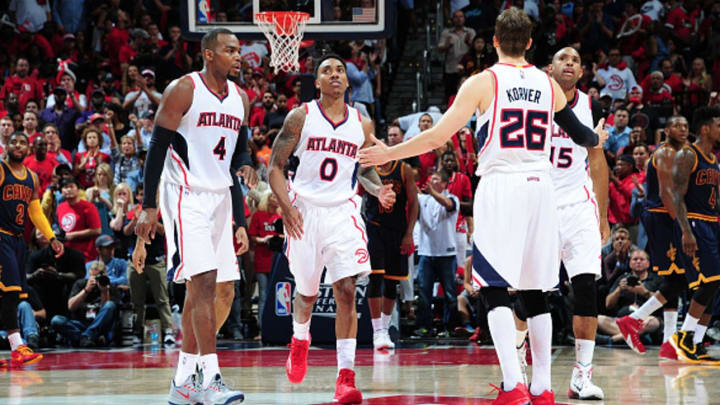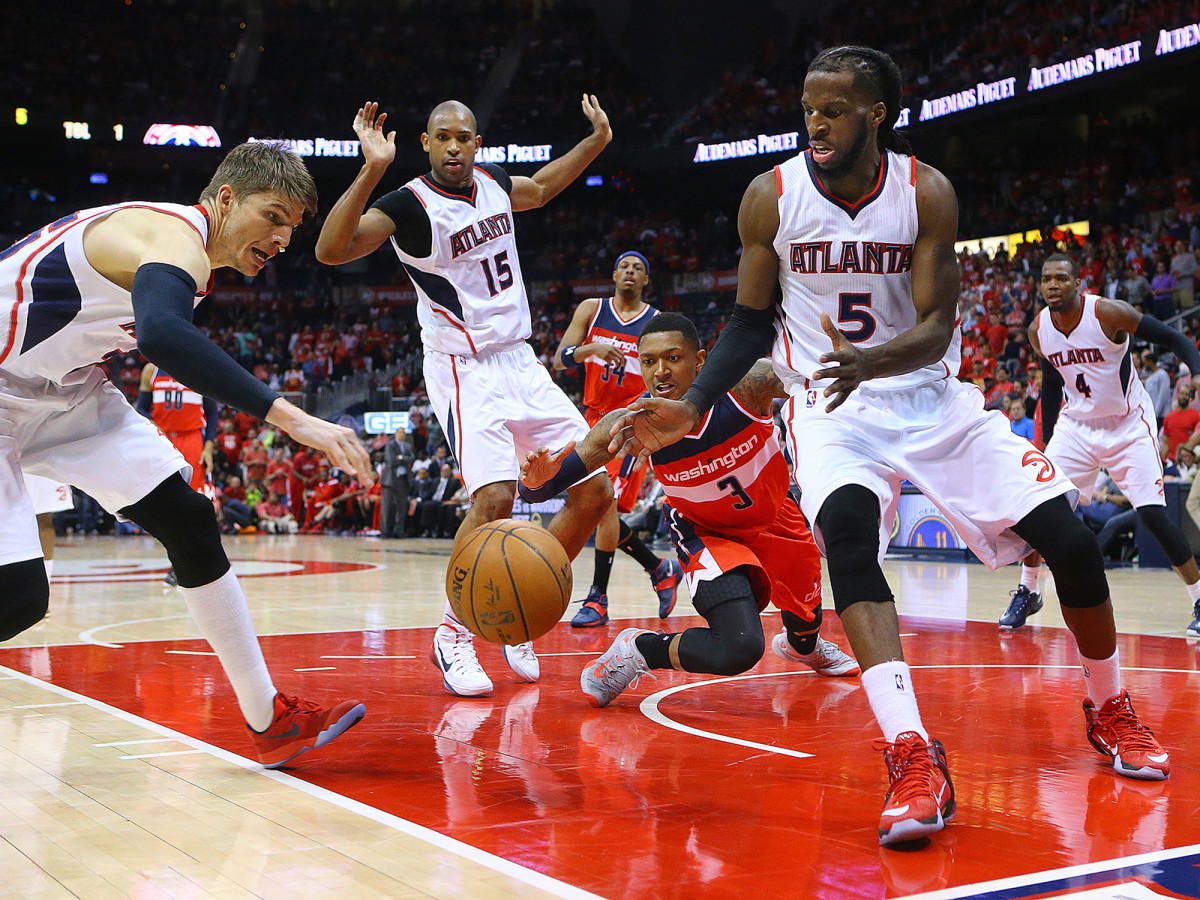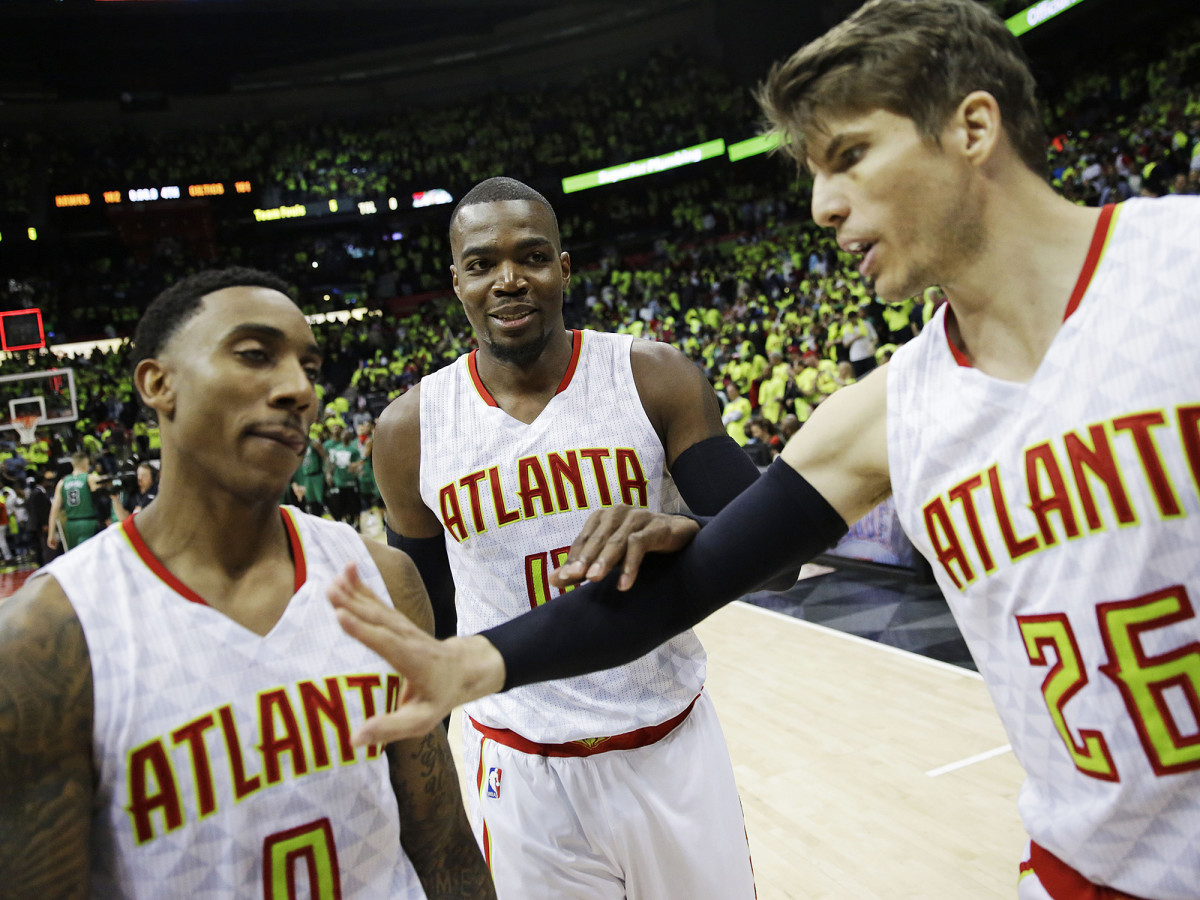'It Wasn't The Same': What Split Up The Hawks' Famous Starting Five

Perched atop the stone fireplace, an Atlanta Hawks logo presides over Shawn and Carol Teague’s living room. The bird’s claws puncture a basketball, it’s wings outstretched and etched white onto a spherical piece of glass. It’s one of five identical trophies acknowledging the Co-Eastern Conference Players of the Month from January 2015, when the couple’s son, Jeff, Kyle Korver, DeMarre Carroll, Paul Millsap and Al Horford quite literally dominated the NBA.
Atlanta’s perfect 17–0 slate set a record for the most prolific month in league history. The team’s Twitter profile began adding W’s to elongate its “ATLHawks” handle in lockstep with their franchise-record winning streak. Wins piled so rapidly, the gimmick was only curtailed by the social network’s pesky character limit. “It was five guys that enjoyed playing with another and all wanted to win,” Teague told The Crossover. “It wasn’t about stats or anything.”
Yet triumph can be fickle and success in the NBA can prove especially fleeting. A team’s window for contention may only creak open for a moment, like the seconds before a defense—such as those Hawks—collapses on a penetrating point guard. In the blink of an eye, a world-beater starting lineup can be dispersed across an entire conference.
Crystal Ball: Who Will Win the 2017 NBA Finals?
Teague’s award arrived in Indianapolis this summer when he was traded to his hometown Pacers in June. His Indiana team is engaged in a first-round battle with Korver, dealt in January, and the Cavaliers. The winner will likely face Carroll’s Raptors. On the other side of the Eastern bracket, Horford’s top-seeded Celtics could draw Millsap—the lone-remaining starter—and the Hawks in round two. “I would have never imagined it,” Horford said. “It’s a little strange,” said Atlanta coach Mike Budenholzer. “It seems like it’s years and years removed,” said reserve forward Thabo Sefolosha.
The business of basketball can be cruel, turning players into mere names on a transaction log. Only relationships can withstand the carousel that often dizzies and derails rosters. It was Korver and Millsap’s bond that originated Atlanta’s prominence, after all. Following three years together in Utah, the sharpshooter phoned Millsap early into his free agency in 2013. As Atlanta parted ways with Josh Smith, the Hawks fixated on Millsap’s versatile skillset to compliment Horford in Budenholzer’s spacious offense. “He just talked about Coach Bud, what type of style of play we was gonna play,” Millsap remembered. “It sounded great.”
The Hawks installed Horford as its bedrock with No. 3 overall selection in 2007. Teague, the 19th pick in 2009, joined two years later. Korver arrived via a July 2012 trade with the Chicago Bulls. After Millsap’s marquee signing, Carroll, another Jazz teammate, followed in August 2013. Atlanta didn’t rise from a splashy off-season rebuild. The Hawks’ flight to prominence cultured within Budenholzer’s petri dish.

It happened almost by accident. With Horford shelved for the season due to a torn pectoral muscle, Pero Antic filled his void in the 2014 playoffs against the Pacers. Antic’s shooting ability allowed Atlanta to stretch Indiana’s bunkered defense, coaxing Roy Hibbert away from the paint and freeing endless action towards the rim. A dichotomy of styles clashed and allowed an inferior talent to last seven games. The lineup boasted a 12.1 net rating in 114 postseason minutes. “The group moved on and they figured it out,” Horford said. Yet the Hawks sputtered to start the 2014–15 campaign, dropping three of their first four contests. The rhythm was clunky. The ball stopped whizzing around the perimeter.
“I wasn’t up to speed with the guys and what we needed to do,” Horford admitted. In late November, Budenholzer summoned the center to his office. He was out of sync on pick-and-rolls with Teague. The Hawks’ defensive rotations stalled, its coordination in transition collapsed and Horford was responsible. “He just kept challenging all of us,” Horford said. “And I think that at that point, we really started to play better as a unit and we really took off from there.” Atlanta subsequently compiled nine-straight wins to open December and dropped only two more games before Feb. 2.
“We had a stretch there where everything was clicking,” Korver said. “I’ve always been kind of a purist in that way; enjoying the cutting and the ball movement; the passing, the screening, the shooting; finding ways to get easy shots, you know? All five guys are on a string, and I felt like that was probably the best basketball that I’ve ever been a part of in that way.”
The Hawks arrived in your hometown, entered your arena and methodically dismantled you. Then they jetted for the next city, engaging in heated games of UNO 39,000 feet in the air. On a whim, Teague purchased a pack of the rainbow card game from a gas station before a road trip that fateful January “and it kind of took on its own life,” he said. “Then all of a sudden,” said Horford, “Jeff, Dennis [Schroeder], Kyle, me, we were the ones that first started it and then we kept adding guys in.” By combining multiple packs, the Hawks would unleash a series of Draw 4s like a barrage of three-pointers.
Horford also engaged Millsap in a fiery Chess with Friends rivalry. “He’s very methodical. He plays pretty slow,” Millsap said. “I’m more aggressive. I trade pieces in a minute. I’m a straight to the point kind of guy.” The varied personalities of Atlanta’s starting unit helped their chemistry. “Jeff was probably the instigator of the group,” Korver told The Crossover. “Kyle is a thinker and he was definitely one of our leaders,” said Horford. “The heart of that group would probably be DeMarre,” Teague added.
As the Hawks soared to the top of the Eastern Conference standings, Horford, Millsap, Teague and Korver all earned All-Star nods, with Budenholzer on the bench. “We all knew that it was because of the team that we were all there and that made it really special,” Korver said.

But the magic disappeared against Cleveland in the conference finals. Carroll sprained his left knee in the fourth quarter of Game 1. He returned two days later, but lacked the power and strength to stymie LeBron James’s bulldozes to the rim. And in the third quarter of that second game, Matthew Dellavedova’s awkward fall onto Korver’s leg caused a high ankle sprain and sidelined the All-Star for the remainder of the postseason. “We went that whole year without injuries,” Teague said. “We got to the conference finals and it finally got us.”
It was over before it ever began. Budenholzer’s harmonious starting lineup began to dissipate like Marty McFly’s family photo. Carroll departed to Toronto in free agency that July. “I don’t think the Hawks have been the same since,” said Teague. The next season, a tug-of-war emerged between Teague and Schroeder during a campaign that culminated in another sweep at the hands of Cleveland. Teague met Budenholzer for lunch shortly after the series. In between bites, both coach and point guard made it clear they were open to change. The front office had grown increasingly bullish on Schroeder’s future. “You could feel it. I’m sure everybody felt it,” Teague said. “It was bittersweet, but I knew it was coming.”
Horford spurned Atlanta for Boston just a few weeks following Teague’s trade to Indiana. When the Celtics first visited Bankers Life Fieldhouse this season, Teague asked his former teammate why he departed the only professional city he had ever known. “The group wasn’t there,” Horford whispered. “It wasn’t the same.” Suddenly, only Korver and Millsap remained, striving to resuscitate a contender. “We always reflected on that year,” Millsap said. The weirdest stroke of fate, Korver’s trade to Cleveland, of all destinations, left Millsap alone.
Atlanta has returned to the playoffs for the 10th straight season, the second-longest streak in the league. Millsap has shouldered the franchise while surveying his former teammates’ success. “I’m always keeping track of that, looking at the scores, seeing what they’re doing,” he said. A member of that 60-win team will likely represent the East in the Finals, emerging from at least one battle against a former ally. “We’re friends until we step on the court,” said Carroll.
The stage will be bright. The history will stand forever. The taste of the title, however, can disappear the moment it hits your lips.
